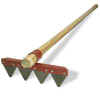 |
 |
 |
 |
| Wildland
tools
This shows the most
common wildland firefighting hand tools. The forestry shovel, Pulaski
and McLeod.
|
Forestry
shovel
The forestry shovel is
simply a short handled round point shovel but it is one of the most versatile wildland hand tools. It can be used to cut small trees or brush, scrape away light fuels like grass and is used to throw dirt on a fire slowing the spread of the flames.
|
McLeod
The McLeod is a
combination rake and cutting / scraping tool. It is named after it's
credited inventor, Malcolm McLeod an early 20th century US Forest Service firefighter.
|
McLeod
detail
Close up of the tool
head, the orange plastic guard covers the sharp edge. In addition to its use as a wildland tool, the large teeth make the McLeod popular with some structural firefighters for looking for hot spots in the ashes of structure or trash fires.
|

|

|

|

|
| Pulaski
The Pulaski is a
combination axe and hoe used to cut brush and dig up roots. It is named
for its credited inventor, Edward Pulaski an early 20th century US Forest Service
firefighter.
|
Pulaski
detail
Close up of the tool
head.
|
Combi-tool
The combi-tool resembles
a military entrenching tool but is much larger. The head can be
configured in several ways allowing the tool to be used as a pick,
shovel or scraping tool. It is also a nice height for leaning on making
it popular with crew leaders.
|
Swatter
The swatter is used to
beat out and smother fires in light fuels like grass. This is one of the earliest specialized tools created for wildland fires. It is still used
in some areas but is not particularly common. A similar "tool" is often made by cutting a green tree branch and using that to beat the flames.
|

|

|

|

|
| Brush
hook
Brush hooks are similar
to an axe but their shape allows the brush hook to cut through brush better. They have been largely replaced by chainsaws but are still occasionally found.
|
Council
rake
The council rake is used
in areas that have thick ground cover such as vines or roots. The teeth are
sharp helping the tool cut through thick vegetation.
|
Two
man crosscut saw
Saws like this were first
used in the late 1800's, they remained common with wildland firefighters
until the mid 70's when small portable chainsaws became readily
available. These saws are still used in wilderness areas and are
particularly common with smokejumpers and helitack crews. Old fire hose is popular as a cover to protect the teeth of the
saw. They range in length from 48" - 84".
|
Two man crosscut saw The
handles on these saws are removable to make transport and storage
easier. Newer saws must be carried flat but the older saws (pre-WW2) could be bent into a horseshoe for easier transport without damaging the saw. The older saws are highly prized for this feature and many saws made in the early part of the century are still in use today.
|

|

|

|

|
| One
man crosscut saw
This is a smaller version
of the crosscut saw intended for use with one person. It has a removable
handle allowing it to be used as a small 2 man saw.
|
Falling
axe
A flat head axe like this
is used with a cross cut saw or chainsaw when felling trees. It is used
to remove small limbs and for driving wedges.
|
Drip
torch
The drip torch is used to
light fires this is done to remove fuel before the main fire arrives
strengthening the fire line (burning out) or to start a fire that will influence
the main fires direction or intensity (backfire).
|
Drip
torch
Another view. The drip
torch is filled with a mixture of gasoline and diesel fuel. It is
commonly used in prescribed fires and wildland fires.
|

|

|

|

|
| Back
pack pump
The back pack pump has a
flexible bladder holding 5 gallons of water, the trombone style sprayer
is used to manually spray the water. It is also popularly known as a bladder bag
or piss pump.
|
Back
pack pump
Another view. The
flexible bladder style of back pack pump such as this one have largely
replaced the older rigid metal can style.
|
Back
pack pump
This is an older style of
back pack pump. It is basically the same as the bladder style except for
the obvious rigid tank.
|
Back
pack pump
Another view. This style
pump is often called an Indian pump since this was the brand name
used by a major manufacturer. It is also called a can for obvious
reasons.
|